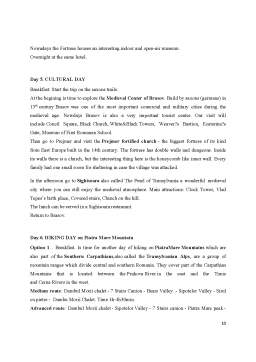Extras din proiect
Transylvania is a historical autonomous region on the west side of present day Romania. Bounded on the east and south by its natural borders, the Carpathian mountain range, historical Transylvania extended in the west to the Apuseni Mountains; however, the term sometimes encompasses not only Transylvania proper, but also the historical regions of Crișana, Maramureș, and Romanian part of Banat.
The name of “Transylvania” comes from the Latin expression -Trans Silva – which means “the land beyond the forests”, due to the forests which covered the mountains in the area.
The region of Transylvania is known for the scenic beauty of its Carpathian landscape and its rich Hungarian and Saxon history. In the English-speaking world it has been commonly associated with vampires, chiefly due to the influence of Bram Stoker's famous novel Dracula as well as the many later film adaptations.
Transylvania is the largest region of Romania and probably the best known one. When you visit Transylvania you dive into a mix of cultures, nature and history. Transylvania is a diverse region: it is worth trying to observe the differences that exist within the region, both culturally and naturally. This region is a place with abundant history and multicultural convergence. All over Transylvania the cohabitation of Romanians, Hungarians, Saxons and Roma is the leading theme.
Transylvania is rich in myth and misty medieval sites: there about 100 castles and fortresses and about 70 fortified churches. Romania's greatest and best preserved castles and fortresses are to be found here. But for the more curious traveler, there are many small villages with old houses and fortified churches. As Transylvania is circled by the Carpathian mountains there are a lot of mountain forests and hiking or climbing possibilities. All over the Carpathians there are great national parks. In the center of Transylvania there are green hills and rivers.
Most big cities are very western Europe like, and the infrastructure is generally good, making it easy for travelers.
Area and population: The territory of Transylvania covers 16 counties (Romanian: judeţ), with an area of 99,837 km2 (38,547 sq mi), in central and northwest Romania.
The 16 counties are: Alba, Arad, Bihor, Bistriţa-Năsăud, Brașov, Caraș-Severin, Cluj, Covasna, Harghita, Hunedoara, Maramureș, Mureș, Sălaj, Satu Mare, Sibiu, and Timiș.
This region has a population of 7,221,733, with a large Romanian majority (75.9%). There are also sizeable Hungarian (19.6%), Roma (3.3%), German (0.7%) and Serb (0.1%) communities.
The population is mostly of Hungarian origin in Harghita County (84.8%) and Covasna County (73.6%). The Hungarians are also numerous in the following counties: Mureş (37.8%), Satu Mare (34.5%), Bihor (25.2%) and Sălaj (23.2%).
The most populous cities (as of 2013 census): Cluj-Napoca 324.576 people; Brașov 253.200 people; Sibiu 147.245 people; Târgu Mureș 134.290 people and so on.
Climate: The climate in Transylvania is that of continental Europe. The summers are generally hot; however, the temperature can drop during the night, so pack a warm jumper. In the winter, warm, waterproof clothing and boots is a must.
Extreme temperatures can approach 40 degrees in the summer (but not quite reach it), and descend below 30 in the winter (especially in the eastern parts).
Language: Nowadays, almost everyone in Transylvania speaks Romanian, though for many of the ethnic Hungarians -- about 20% of the population, but far more in certain areas -- Hungarian is actually their first language.
Few native German-speakers remain, but in any sizable town you should easily be able to find people who speak at least moderately good English, French, or German.
Religion: Each of Transylvania's three principal nationalities is divided across two or more religions. Most Transylvanian Romanians belong to either the Romanian (Eastern) Orthodox church or the Uniate church (a hybrid of Eastern Orthodoxy and Roman Catholicism that the Habsburgs created in the late 1600s, with the aim of Catholicizing Transylvania's Romanians).
Economy: Transylvania is rich in mineral resources, notably lignite, iron, lead, manganese, gold, copper, natural gas, salt and sulfur.
There are large iron and steel, chemical, and textile industries. Stock raising, agriculture, wine production and fruit growing are important occupations. Timber is another valuable resource.
IT, electronics and automotive industries are important in urban and university centers like Cluj-Napoca (Nokia), Timișoara (Alcatel-Lucent, Flextronics and Continental AG), Brașov, Sibiu, Oradea and Arad.
Transylvania accounts for around 35% of Romania's GDP, and has a GDP per capita (PPP) of around $11,500, around 10% higher than the Romanian average.
Preview document
Conținut arhivă zip
- Transylvania - General Presentation.docx

















